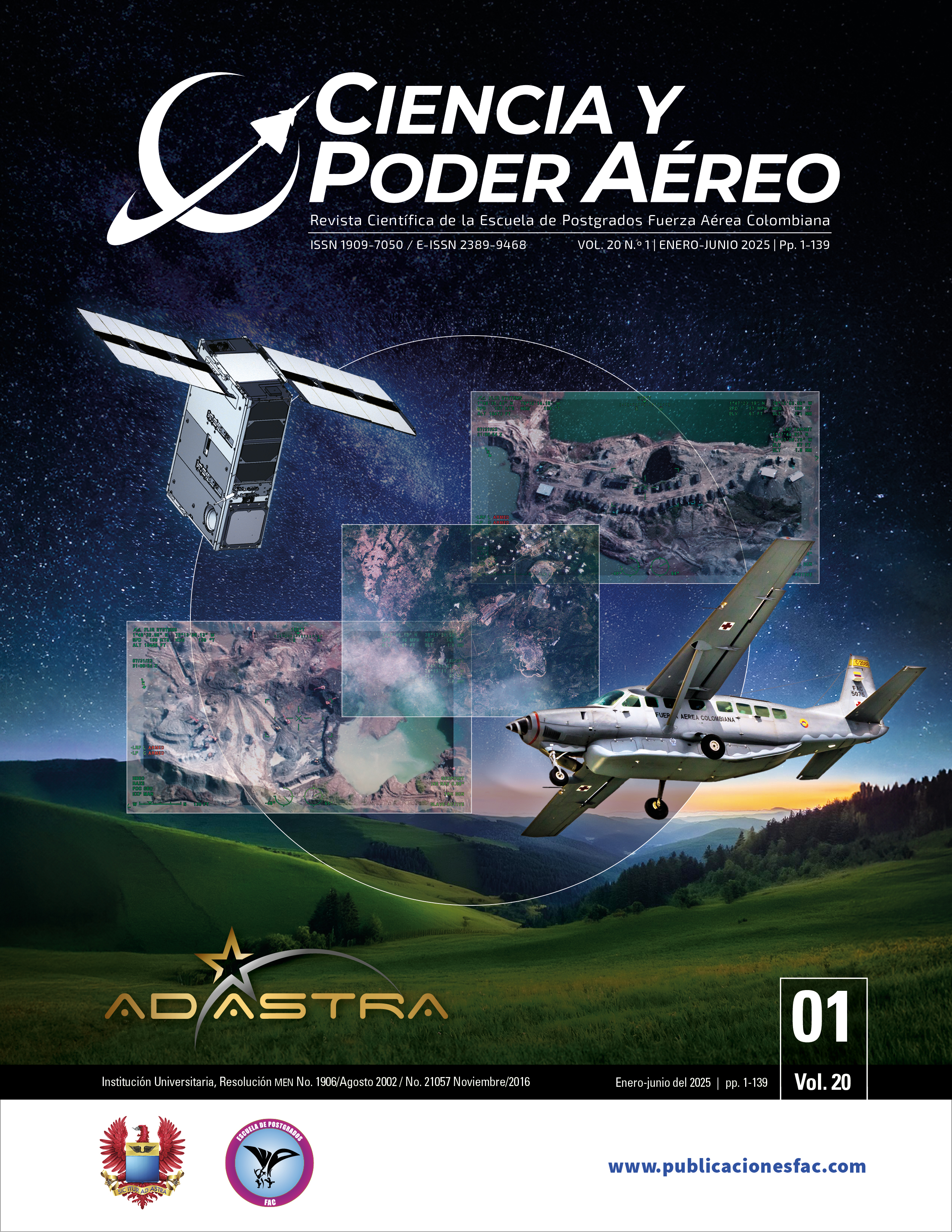Fundamentals and structureof the Colegio del Aire
DOI:
https://doi.org/10.18667/cienciaypoderaereo.828Keywords:
Educational administration, higher military education, funding, education management, strategic planningAbstract
The main issue in Higher Military Education is the lack of information about it—little is known, and even less is published in Mexico. In military education, as in other educational systems, success or failure depends on how management, strategic planning, and the processes for operating that planning are carried out. These possibilities are natural, as in all organizations, from the way its structure is designed, the planning, strategies, and operational tactics, to administration.
This research was conducted with the objective of exploring the management practices at the Air College, an institution of higher education within Mexico’s military education system, to identify its conception, regulations, structure, funding, and strategic planning. It is a documentary investigation with a qualitative approach from an analytical perspective, through the review and analysis of official documents to identify its policies, regulations, governance, administration, strategic planning, and funding. It is worth noting that military education in Mexico has over two hundred years of history. The institution analyzed was founded in 1959 and has strengths, such as recognition in the training of Mexican Air Force officers to ensure the security of airspace. It also has specialists in aeronautics and military administration and is a consolidated organization. Opportunities include forming partnerships with other civilian educational institutions, and management and strategic planning are areas that deserve improvement.
Downloads
References
Arellano-Gault, D. (2004). Gestión estratégica para el sector público. Del pensamiento estratégico al cambio organizacional. Fondo de Cultura Económica.
Casassus, J. (1998). Descentralización de la gestión a las escuelas y calidad de la educación: ¿mitos o realidades? Propuesta Educativa, 10(21).
DiMaggio, P. J. y Powell, W. (1994). Retorno a la jaula de hierro: el isomorfismo institucional y la racionalidad colectiva en los campos organizacionales. El nuevo institucionalismo en el análisis organizacional (W. Powell & P. DiMaggio, comps.; pp. 104-125). Fondo de Cultura Económica.
Fernández, J. (2008). La educación militar en México: un enfoque histórico. Revista Mexicana de Investigación Educativa, 13(37), 813-835.
García, A. (2017). La educación militar en México: una perspectiva histórica. Estudios de Historia de la Educación, 18, 83-98.
Gutiérrez-Albán, L. G., Teneda Garcés, V. O y Narváez Ríos, R. R. (2019). La formación militar desde el enfoque por competencias: caso tecnología superior en ciencias militares. Revista de Ciencias de Seguridad y Defensa 4(8), 107-114.
Klepak, H. (Comp.). (2012) Formación y educación militar: los futuros oficiales y la democracia. Resdal [en línea]. https://www.resdal.org/educacion/educacion-militar.pdf
Lemaitre, M. J. (Ed.). (2018). La educación superior como parte del sistema educativo de América Latina y el Caribe: calidad y aseguramiento de la calidad. Unesco.
López, A. (2003). El Calmécac: una institución educativa en la cultura mexica (Azteca). Estudios de Cultura Náhuatl, 34, 41-56.
Mendoza Rojas, J. (2016). Financiamiento de la educación superior en la primera mitad del gobierno de Enrique Peña Nieto: ¿fin del periodo de expansión? Perfiles Educativos | vol. XXXIX, núm. 156. IISUE-UNAM DOI: https://doi.org/10.22201/iisue.24486167e.2017.156.58288
Organización para la Cooperación y el Desarrollo Económicos (OCDE). (2019). El futuro de la educación superior en México: fortalecimiento de la calidad y la equidad. Revisión de Políticas Nacionales de Educación. oecd Publishing. https://doi.org/10.1787/005689e0-es DOI: https://doi.org/10.1787/005689e0-es
Panfilov, A. y Petrova, L. (2018). La educación militar es la estrategia principal de formación de la personalidad de los líderes militares modernos. Universidad Nacional de Derecho Yaroslav Mudryi [en línea]. https://doi.org/10.21564/2075-7190.38.140005 DOI: https://doi.org/10.21564/2075-7190.38.140005
Robbins, S. P. y Judge, T. A. (2020). Comportamiento organizacional (17.a ed.). Pearson Educación.
Secretaría de la Defensa Nacional (SEDENA). (2019). Reseña histórica del Heroico Colegio Militar [en línea]. https://www.gob.mx/sedena/acciones-y-programas/resenahistorica-del-heroico-colegio-militar
Secretaría de la Defensa Nacional (SEDENA). (2022a). Actividades militares de la Escuela Militar de Aviación [en línea]. https://www.gob.mx/sedena/acciones-y-programas/actividades-militares-de-la-escuela-militar-de-aviacion
Secretaría de la Defensa Nacional (SEDENA). (2022b). Colegio del Aire [en línea]. https://www.gob.mx/sedena/acciones-y-programas/colegio-del-aire-318435
Secretaría de la Defensa Nacional (SEDENA). (2022c). Historia del Colegio del Aire. Antecedentes históricos [en línea]. https://www.gob.mx/sedena/acciones-y-programas/historia-del-colegio-del-aire
Secretaría de la Defensa Nacional (SEDENA). (2023). Sistema educativo militar [en línea]. https://www.gob.mx/sedena/articulos/sistema-educativo-militar-31103
Transparencia Presupuestaria. (2023). Presupuesto de Egresos de la Federación (PEF). Plataforma de datos abiertos [en línea]. https://www.transparenciapresupuestaria.gob.mx/Datos-Abiertos
Downloads
Published
Issue
Section
Categories
License
Copyright (c) 2024 Escuela de Postgrados de la Fuerza Aérea Colombiana

This work is licensed under a Creative Commons Attribution 4.0 International License.
Assignment of Copyrights
Authors assign Ciencia y Poder Aéreo journal the exclusive rights (reproduction, distribution, public communication, and transformation) to exploit and commercialize their work, in whole or in part, in all the formats and modalities of present or future exploitation, in all languages, throughout the life of the work and throughout the world.
All contents published in Ciencia y Poder Aéreo journal are licensed under a Creative Commons Attribution 4.0 International License, whose complete information is available at http://creativecommons.org/licenses/by/4.0/
Under the terms of this license, users are free to download, print, extract, archive, distribute and publicly communicate the content of articles, provided that proper credit is granted to authors and Ciencia y Poder Aéreo, scientific journal of the Graduate School of the Colombian Air Force. Except when otherwise indicated, this site and its contents are licensed under a Creative Commons Attribution 4.0 International License.
For other uses not considered under this license it is required to contact the Director or the Editor of the journal at the e-mail address cienciaypoderaereo1@gmail.com.
The Graduate School of the Colombian Air Force and this publication are not responsible for the concepts expressed in the articles, including the metadata or the affiliation stated by authors. This is the full responsibility of the authors.






















